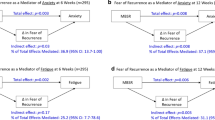Abstract
This paper describes a randomized clinical trial investigating a stress management program for women with breast cancer, which inadvertently turned quasi-experimental. Due to logistical considerations, group assignment was disclosed to participants (n = 63) prior to baseline assessment. Analyses of baseline measures unexpectedly revealed statistically significant differences between groups on psychological functioning. We suggest that what appears to be failed randomization may in fact point toward an important phenomenon which we have termed premature disclosure effect (PDE). A hierarchical regression model, developed to help explain the PDE, accounted for 47% of the variance. The findings indicate the importance of considering participant belief, preferences, and attributes when designing research protocols and interventions. Potential implications of PDE for clinical research in behavioral medicine are discussed and specific statistical methodologies suggested.
Similar content being viewed by others
REFERENCES
Antonovsky, A. (1987). Unveiling the Mystery of Health: How People Manage Stress and Stay Well, Jossey‐Bass, San Francisco.
Beck, A. T., Ward, C. H., Mendelson, M., Mock, J., and Erbaugh, J. (1961). An inventory for measuring depression. Arch. Gen. Psychiatry 4: 561–571.
Cohen, J. (1988). Statistical Power Analysis for the Behavioral Sciences, 2nd ed., Lawrence Earlbaum Associates, Hillsdale, NJ.
Cook, T. D., and Campbell, D. T. (1979). Quasi-Experimentation: Design and Analysis Issues for Field Settings, Houghton Mifflin, Boston.
Cronbach, L. J., and Snow, R. E. (1977). Aptitudes and Instructional Methods: A Handbook for Research on Interactions, Irvington, New York.
Crowne, D. P., and Marlowe, D. (1964). The Approval Motive: Studies in Evaluative Dependence, Wiley, New York.
Derogatis, L. R., Morrow, G. R., Fetting, J., Penman, D., Piastesky, S., Schmale, A. M., Henrichs, M., and Carnicke, C. L. M. (1983). The prevalence of psychiatric disorders among cancer patients. JAMA 249: 751–757.
DiClemente, R. J., and Temoshok, L. (1985). Psychological adjustments to having cutaneous malignant melanoma as a predictor of follow-up clinical status. Psychosom. Med. 47: 81.
Efron, B. (1971). Forcing a sequential experiment to be balanced. Biometrics 58: 403–407.
Freidenbergs, I., Gordon, W., Hibbard, M., Levine, L., Wolf, C., and Diller, L. (1982). Psychosocial aspects of living with cancer: A review of the literature. Int. J. Psychiatry Med. 11: 303–329.
Jensen, M. (1987). Psychobiological factors predicting the course of breast cancer. J. Person. 55: 317–342.
Gorsuch, R. L. (1983). Three methods of analyzing limited time series (N of 1) data. Behav. Assess. 5: 141–154.
Greer, S., Morris, T., and Pettingale, K. W. (1979). Psychological response to breast cancer: Effect on outcome. Lancet 2: 785–787.
Greer, S., and Silberfarb, P. M. (1982). Psychological concomitants of cancer: Current state of research. Psychol. Med. 12: 563–573.
Hsu, L. M. (1989). Random sampling, randomization, and equivalence of contrasted groups in psychotherapy outcome research. J. Consult. Clin. Psychol. 57: 131–137.
Kirsch, I., and Weixel, L. J. (1998). Double-blind versus deceptive administration of a placebo. Biomed. Ther. XVI(3): 242–246.
Kline J.P., and Schwartz, G. E. (1995). Repression, emotional disclosure, and health: Theoretical, empirical, and clinical considerations. In Pennebaker, J.W. (ed.), Emotion, Disclosure and Health, pp. 177–193.
McNair, D. M., Lorr, M., and Droppleman L. F. (1981). Profile of Mood States (POMS), 2nd Ed. Educational and Industrial Testing Service, San Diego,CA.
Meyer, T. J., and Melvin, M. M. (1995). Effects of psychosocial interventions with adult cancer patients: A meta-analysis of randomized experiments. Health Psychol. 14(2): 101–108.
Pettingale, K.W., Morris, T., Greer, S., and Haybittle, J. (1985). Mental attitudes to cancer: An additional prognostic factor. Lancet I: 750.
SAS Institute, Inc. (1996). SAS Language and Procedures, Version 6, 4th ed. SAS Institute, Cary, NC.
Schwartz, G. E. (1984). Psychobiology and health: A new synthesis. In Hammonds, B. L., and Scheirer, C. J. (eds.), Psychology and Health: Master Lecture Series, 3, American Psychological Association, Washington, DC, pp. 145–195.
Shapiro, A. K., and Shapiro, E. (1997). The Powerful Placebo: From Ancient Priest to Modern Physician, The John Hopkins University Press, Baltimore.
Shapiro, D. H. (1992). Shapiro Control Inventory (SCI), Behaviordyne, Palo Alto, CA.
Spielberger, C.D., Gorsuch, R.C., and Lushene, R.E. (1970). Manual for the State-Trait Anxiety Inventory, Consulting Psychologists, Palo Alto, CA.
Author information
Authors and Affiliations
Corresponding author
Rights and permissions
About this article
Cite this article
Shapiro, S.L., Figueredo, A.J., Caspi, O. et al. Going Quasi: The Premature Disclosure Effect in a Randomized Clinical Trial. J Behav Med 25, 605–621 (2002). https://doi.org/10.1023/A:1020693417427
Issue Date:
DOI: https://doi.org/10.1023/A:1020693417427




